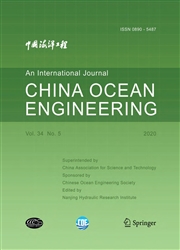Wave Attenuation Performance and the Influencing Factors of A LowerArc-Plate Breakwater
作者:LI Xue-yan,WANG Qing,YOU Zai-jin,GUO Wei-jun,ZHANG Jun-bin,ZHAN Chao,ZHANG Zhi-chen,WANG Li-xue,LI Qin
摘要:Comprehensive experimental and numerical studies have been undertaken to investigate wave energy dissipation performance and main influencing factors of a lower arc-plate breakwater. The numerical model, which considers nonlinear interactions between waves and the arc-plate breakwater, has been constructed by using the velocity wave- generating method, the volume of fluid (VOF) method and the finite volume method. The results show that the relative width, relative height and relative submergence of the breakwater are three main influencing factors and have significant influence on wave energy dissipation of the lower arc-plate open breakwater. The transmission coefficient is found to decrease with the increasing relative width, and the minimum transmission coefficient is 0.15 when the relative width is 0.45. The reflection coefficient is found to vary slightly with the relative width, and the maximum reflection coefficient is 0.53 when the relative width is 0.45. The transmission and reflection coefficients are shown to increase with the relative wave height for approximately 85% of the experimental tests when the relative width is 0.19 0.45. The transmission coefficients at relative submergences of 0.04, 0.02 and 0 are clearly shown to be greater than those at relative submergences of 0.02 and 0.04, while the reflection coefficient exhibits the opposite relationship. After the wave interacts with the lower arc-plate breakwater, the wave energy is mainly converted into transmission, reflection and dissipation energies. The wave attenuation performance is clearly weakened for waves with greater heights and longer periods.
发文机构:Coast Institute Dalian Maritime University Institute of Sea-Crossing Engineering College of Environmental Sciences and Engineering
关键词:arc-plateBREAKWATERWAVEATTENUATIONPERFORMANCEinfluencingfactorsVOFmethod
分类号: O17[理学—数学][理学—基础数学]
- Hydrodynamic Study on Energy Capturing Performance of Horizontal Axis Blades Under Sub-Low Speed Tidal Current
- Structural Model Updating of Jacket Platform by Control Theory Using Vibration Measurement Approach
- Study on the Overload and Dwell-Fatigue Property of Titanium Alloy in Manned Deep Submersible
- Modal Parameters Identification of A Real Offshore Platform From the Response Excited by Natural Ice Loading
- MPS Method for Interaction Between Solitary Waves and Submerged Horizontal Plate
- Influence Analysis and Vibration Restraint Solutions Research on the Underwater Acoustic Monitoring System
- Fully Coupled Simulation of Interactions Among Waves, Permeable Breakwaters and Seabeds Based on N−S Equations
- Extreme Wave Simulation with Iterative Adaptive Approach in Numerical Wave Flume
- Experimental Investigation of Disturbing the Flow Field on the Vortex-Induced Vibration of Deepwater Riser Fitted with Gas Jetting Active Vibration Suppression Device
- Fluid Mud Measurement and Siltation Analysis in A Trial Excavated Channel in the Approach Channel of the Xiangshan Port


